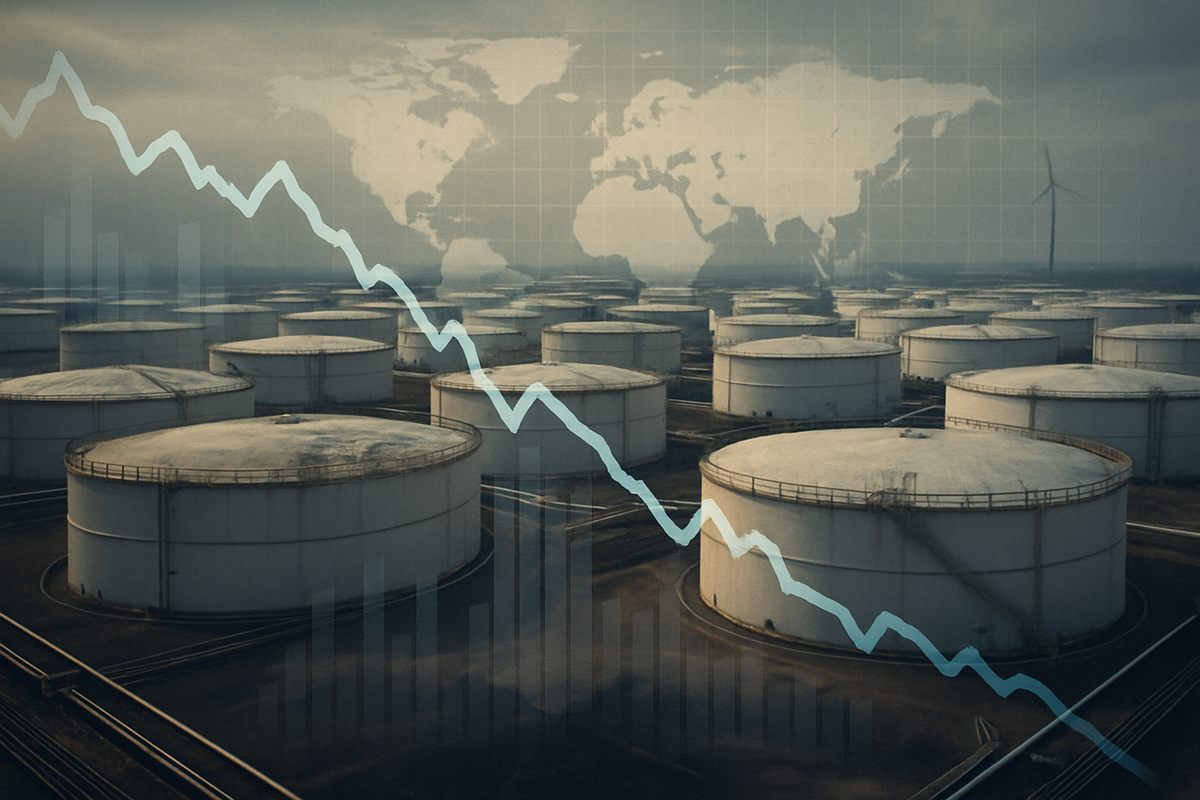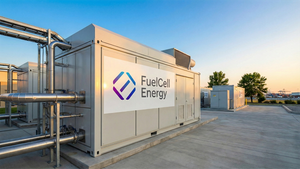
US crude oil inventories have seen a significant and unexpected surge in early October 2025, with commercial crude stocks rising by a substantial 3.7 million barrels in the week ending October 3, 2025. This build, far exceeding analyst expectations, typically signals weakening demand and casts a bearish shadow over crude prices. However, immediate market reactions have been complex and somewhat contradictory, with benchmark crude prices experiencing short-term rallies driven by other key market dynamics, including OPEC+ production decisions and robust demand for refined products.
The larger-than-anticipated inventory build has introduced a fresh layer of uncertainty into an already volatile energy market. While the immediate implication points to an oversupplied market, the nuanced response from oil benchmarks suggests that the broader energy landscape is being shaped by a confluence of factors beyond just domestic stock levels. This development sets the stage for a critical period for energy producers, refiners, and consumers alike, as the market attempts to reconcile burgeoning supply with evolving demand patterns and geopolitical influences.
Inventory Overload: Dissecting the Latest US Crude Stockpile Surge
The latest data from the U.S. Energy Information Administration (EIA), released on October 8, 2025, revealed that commercial crude oil inventories, excluding the Strategic Petroleum Reserve, swelled by an astonishing 3.7 million barrels, reaching a total of 420.3 million barrels. This figure dramatically outstripped the consensus forecast of a mere 700,000-barrel increase, more than doubling the previous week's build of 1.792 million barrels. This substantial accumulation marks a critical moment for the global oil market, highlighting a potential imbalance between supply and demand.
Several interconnected factors contributed to this considerable inventory expansion. US crude oil production played a pivotal role, estimated at a robust 13.6 million barrels per day (b/d), an increase of 124,000 b/d from the prior week. This record-high production, which saw the EIA revise its 2025 and 2026 forecasts upward to 13.5 million b/d for each year, underscores the resilience and efficiency of American shale producers. Concurrently, crude oil imports rose by 570,000 b/d to 6.4 million b/d, while exports experienced a decline of 161,000 b/d, settling at 3.6 million b/d. Despite these bearish indicators, refinery capacity utilization saw a modest uptick of 1 percentage point to 92.4%, with crude input to refineries rising by 130,000 b/d to 16.3 million b/d, suggesting healthy underlying demand for refined products.
Initial market reactions to the inventory report were notably mixed. Despite the significant crude build, both West Texas Intermediate (WTI) (NYMEX: CL=F) and Brent crude (ICE: BZ=F) prices extended earlier rallies on October 8. WTI crude traded around $62.25 per barrel, up nearly 0.80% for the day, while Brent crude climbed close to $66 a barrel, up 1.30%. This counter-intuitive price movement was primarily attributed to the Organization of the Petroleum Exporting Countries and its allies (OPEC+) decision to implement a smaller-than-expected production hike of 137,000 b/d for November, which tempered broader oversupply concerns. Additionally, a drawdown of 763,000 barrels at the Cushing, Oklahoma hub, the Nymex delivery point, alongside lower holdings of refined oil products, hinted at robust underlying demand for gasoline and distillates, providing some support to prices. However, the overarching sentiment among analysts remains bearish, with expectations of continued inventory builds through 2026 exerting downward pressure on prices in the medium to long term.
Corporate Fortunes in Flux: Winners and Losers in an Oversupplied Market
The projected environment of increasing US crude oil inventories and a global oversupply in late 2025 and 2026 is poised to create a distinct divergence in fortunes across the various segments of the public oil and gas industry. With the U.S. Energy Information Administration (EIA) forecasting Brent crude oil prices to average $62 per barrel (bbl) in the fourth quarter of 2025 and further decline to $52/bbl in 2026, and West Texas Intermediate (WTI) potentially trading near $58/bbl by Q4 2025 and around $50/bbl in early 2026, the industry faces significant headwinds. This oversupply is largely driven by robust production from non-OPEC+ nations like the US, Brazil (NYSE: PBR), and Guyana, coupled with OPEC+'s gradual unwinding of production cuts and softer global demand growth, particularly from China and Europe.
Exploration & Production (E&P) companies, whose revenues are directly linked to crude oil prices, are generally anticipated to be among the primary losers in this scenario. Lower crude prices will inevitably lead to reduced capital expenditures, slower production growth, and potential production cuts. While US crude oil production reached a record high of over 13.6 million barrels per day (b/d) in July, it is expected to stabilize around 13.5 million b/d through 2025 and 2026, representing a decline from its recent peak as prices fall. Companies like ExxonMobil (NYSE: XOM) and Chevron (NYSE: CVX), while diversified, will feel the pinch on their upstream profitability. Smaller, independent producers with higher operating costs or significant debt burdens, and those without effective hedging strategies, will be particularly vulnerable. Conversely, low-cost producers with strong balance sheets and diversified portfolios, perhaps with substantial natural gas assets (though natural gas prices are also forecast to be lower), will be more resilient.
Refining companies, however, stand to benefit significantly from increased crude oil inventories and the resulting lower crude prices, as crude is their primary feedstock. Companies such as Marathon Petroleum (NYSE: MPC), Valero Energy (NYSE: VLO), and Phillips 66 (NYSE: PSX) could see improved crack spreads—the difference between crude oil and refined product prices—leading to enhanced profitability. Lower feedstock costs incentivize refiners to increase throughput and utilization rates, with the EIA forecasting refinery utilization to average 91.1% in 2025 and rise to 91.4% in 2026, marking the highest annual average since 2022. Complex refiners capable of processing cheaper, heavier crude grades, coupled with robust marketing and distribution networks, are particularly well-positioned to capitalize on this environment, especially given a projected strong growth year for traditional fuels in 2025 due supported by monetary easing.
Oilfield service companies, including giants like Schlumberger (NYSE: SLB) and Halliburton (NYSE: HAL), are closely tied to the capital expenditure decisions of E&P firms and are generally expected to face headwinds. A reduction in E&P investments due to lower oil prices directly translates to decreased demand for drilling, well completion, and other essential oilfield services. This will likely result in reduced rig activity, lower equipment utilization, and significant pricing pressure on their services, impacting revenues and margins. While offshore oil and gas investment is projected to rebound from 2026 onwards, averaging $57 billion annually between 2026 and 2029, the short-to-medium term poses challenges. Companies offering strong technological solutions that improve efficiency and reduce costs for operators, or those with diversified revenue streams (e.g., exposure to resilient international markets or services focused on optimizing existing production), may fare better than those heavily reliant on conventional drilling in high-cost basins.
Wider Significance: Reshaping Global Energy Dynamics
The recent surge in US crude oil inventories is not an isolated event but rather a critical indicator of broader, transformative trends reshaping the global energy landscape in late 2025 and into 2026. This domestic inventory build reflects a complex interplay of robust supply growth and a notable deceleration in global demand, setting the stage for profound ripple effects across international markets, policy arenas, and historical precedents.
At the heart of this shift is the relentless increase in global oil supply, led significantly by non-OPEC+ nations. The EIA forecasts US crude oil production to average an impressive 13.5 million barrels per day (b/d) in both 2025 and 2026, driven by enhanced efficiency in key shale basins like the Permian and Bakken, alongside accelerated project startups in the Gulf of Mexico. This sustained output ensures that US production consistently outpaces domestic demand. Globally, non-OPEC+ countries, including Brazil (NYSE: PBR), Canada (TSX: CNQ), Guyana, and Argentina, are collectively projected to add 1.4 million b/d in 2025 and over 1 million b/d in 2026. Even OPEC+ is slated to increase production, unwinding previous cuts and adding 1.3 million b/d in 2025 and 1 million b/d in 2026. This burgeoning supply, however, is meeting a weakening global demand environment. The International Energy Agency (IEA) anticipates global oil demand growth of approximately 700,000 b/d for both 2025 and 2026, with demand in advanced economies potentially contracting due to slower economic activity in China and persistent high interest rates. This imbalance is projected to lead to substantial global oil inventory builds through 2026, with the most significant increases expected in Q4 2025 and Q1 2026, exerting considerable downward pressure on crude oil prices, as evidenced by EIA's Brent crude forecasts of $62/bbl in Q4 2025 and $52/bbl in 2026.
These dynamics carry significant ripple effects for global competitors and partners. OPEC+ has been compelled to reorient its strategy, shifting from solely propping up prices through supply cuts to prioritizing regaining market share against the burgeoning non-OPEC+ production. This increased competition puts economic pressure on OPEC+ members and other oil-exporting nations heavily reliant on oil revenues, potentially forcing adjustments to national budgets. Conversely, oil-importing nations and consumers stand to benefit substantially. Lower crude oil prices are anticipated to translate into reduced gasoline prices for US consumers, potentially reaching levels not seen since 2005 (excluding the pandemic year of 2020). This offers economic relief and could allow nations to strategically replenish their Strategic Petroleum Reserves (SPR). China, for instance, has been observed strategically accumulating significant oil inventories, providing a buffer amidst global market uncertainties.
From a regulatory and policy standpoint, governments and international bodies face critical decisions. The active management of SPRs by nations like the US during periods of lower prices and ample supply will be crucial for future energy security. Trade policies, such as tariffs, might be employed to influence oil flows and pricing, as seen historically. Furthermore, the softening of oil demand, partly driven by the increasing adoption of electric vehicles and more fuel-efficient cars, will continue to influence energy transition policies. Regulations promoting "decarbonized" oil, as discussed in Canada, could impact production methods and trade flows, pushing the industry towards greener practices. The US's sustained production surplus and its emerging role as an effective "swing producer" could also enhance its geopolitical leverage in international energy discussions, though ongoing geopolitical tensions remain a significant wild card that could rapidly alter market conditions. Historically, the energy market has experienced cycles of oversupply leading to significant price declines, with past US crude inventory fluctuations consistently driving shifts in investment strategies. The current scenario underscores a fundamental shift in the global balance of power, with the US now playing a role traditionally held by OPEC in balancing supply and demand.
What Comes Next: Navigating a Turbulent Energy Horizon
The significant increase in US crude oil inventories, coupled with a projected global oversupply into late 2025 and 2026, sets the stage for a period of profound re-evaluation and strategic adaptation across the energy sector. The immediate future points to continued price pressure, while the long-term outlook is shaped by both persistent supply dynamics and the accelerating energy transition.
In the short-term (late 2025 - early 2026), the oil market is largely expected to remain bearish. The EIA forecasts Brent crude to average $62 per barrel in Q4 2025 and further decline to $52 per barrel in 2026, with West Texas Intermediate (WTI) following a similar trajectory, potentially reaching $50 per barrel in early 2026. This anticipated price decline is a dramatic shift from recent peaks. Global oil inventories are projected to build significantly, averaging 2.6 million barrels per day (bpd) in Q4 2025 and exceeding 2.7 million bpd in Q1 2026. This build-up is fueled by robust supply growth from non-OPEC+ nations—including the US, Brazil, Canada, and Guyana—and the gradual easing of production cuts by OPEC+, even as global oil demand growth shows signs of weakness due to a slowing Chinese economy, broader macroeconomic uncertainties, and falling demand in industrialized nations. China's strategic stockpiling has provided some support, but its future demand and accumulation pace remain uncertain.
Looking long-term (beyond 2026), the narrative of oversupply is expected to persist, intertwined with the accelerating energy transition. The IEA predicts a record oil surplus in 2026, potentially reaching nearly 3 million bpd, with global oil production capacity rising to 114.7 million bpd by 2030, driven more by natural gas liquids (NGLs) and other non-crude liquids catering to petrochemical demand. This sustained oversupply, combined with the faster-than-expected transition to renewable energy, could see Brent crude slip to $60 by 2030, according to Fitch Ratings. The influence of OPEC+ may also wane if shale and non-OPEC+ production continues to expand unchecked, potentially leading to price wars or forcing OPEC to accept a lower market share in a more competitive environment.
For oil and gas companies, strategic pivots and adaptations are imperative. Prioritizing capital discipline, focusing on margin resilience over volume growth, and maximizing operational efficiency will be crucial. Companies will look to diversify into higher-margin segments like oilfield services and LNG infrastructure, or "defensive" energy assets such as Master Limited Partnerships (MLPs) and natural gas, which is seeing surging demand from AI-driven data centers and US exports. Enhancing supply chain resilience to mitigate cost inflation and uncertainties, alongside increased adoption of digitalization and AI to boost operational efficiency, will also be key. Balancing continued investment in traditional assets with strategic positioning for the energy transition through selective renewable investments and decarbonization methods (e.g., methane emissions efficiency, carbon capture technology) will be critical for long-term viability.
Market opportunities and challenges will emerge. The primary challenge remains declining prices and profitability, which will lead to fiscal strains for oil-dependent economies and reduced upstream capital expenditure. Rapid stock accumulation could also test onshore storage capacity, potentially forcing expensive floating storage solutions and further depressing prices. Macroeconomic headwinds, including high interest rates and trade policies, and persistent geopolitical risks, could exacerbate market volatility. However, opportunities exist in defensive assets like natural gas, midstream infrastructure (e.g., new Permian Basin pipelines), and emerging markets in Africa, India, and Brazil, which show long-term growth potential in both traditional and renewable energy sectors. Technological innovation in carbon capture and hydrogen production also presents promising avenues.
Potential scenarios and outcomes vary. The base case projects continued oversupply and declining prices into early 2026, with Brent settling in the $50-$60 per barrel range. An upside scenario could see temporary price spikes due to unexpected geopolitical supply shocks or a stronger-than-expected demand recovery, potentially hastened by more aggressive OPEC+ production cuts. Conversely, a downside scenario involves a severe global economic downturn, leading to even lower prices and a potential storage capacity crisis. OPEC+ faces a critical policy dilemma between supporting prices and regaining market share. Ultimately, a combination of lower prices, supply adjustments, OPEC policy shifts, and time will be needed to restore market balance, with inventory growth expected to slow later in 2026 as demand strengthens and production adjusts.
Wrap-up: Navigating a Buyer's Market Amidst Global Shifts
The recent surge in US crude oil inventories, alongside robust global supply growth, signals a significant transition towards a buyer's market for crude oil. This trend, expected to persist through late 2025 and into 2026, presents a complex and often contradictory set of signals for investors and policymakers alike, underscoring a fundamental rebalancing of global energy dynamics.
The key takeaways from the current situation highlight a substantial increase in US commercial crude stocks, with recent weekly figures showing a 3.72 million-barrel rise, far exceeding forecasts. This build occurs despite record-high US crude oil production, projected to average 13.5 million barrels per day (b/d) through 2026, and increasing global liquid fuels production driven by non-OPEC+ nations. While OPEC+ has agreed to modest production increases, their actual output may remain below announced targets, providing some moderation to inventory builds. Despite these clear signs of oversupply, oil prices have shown intermittent resilience, often influenced by external factors like OPEC+'s cautious approach and strong demand for refined products.
Moving forward into late 2025 and 2026, the overwhelming sentiment for the crude oil market is one of oversupply and downward pressure on prices. Global oil inventories are projected to rise significantly, with the EIA forecasting Brent crude to average $62 per barrel in Q4 2025 and $52 per barrel in 2026, and WTI following a similar trajectory, potentially reaching $50 per barrel in early 2026. This outlook is shaped by continued strong non-OPEC+ supply, a gradual unwinding of OPEC+ cuts, and moderate global demand growth that is largely outpaced by supply.
The significance and lasting impact of this shift are profound. Lower oil prices could offer a much-needed reprieve for global economies grappling with inflation, easing transportation and energy costs. However, it will exert considerable pressure on oil-producing nations and companies, potentially leading to reduced revenues and squeezed profit margins, particularly for higher-cost producers. The effectiveness of OPEC+ in controlling market prices may diminish as non-OPEC+ supply continues its robust growth, forcing the group to prioritize market share over solely price support. Furthermore, the US's sustained high production levels enhance its energy independence and geopolitical leverage, potentially altering global power dynamics related to energy security.
For investors in the coming months, vigilance and a diversified approach are paramount. Closely monitor weekly US crude oil inventory reports (EIA and API), as consistent builds signal oversupply, while unexpected draws could trigger temporary rallies. Track OPEC+ production compliance and any policy shifts, as their actions remain a critical counterbalancing factor. Keep an eye on non-OPEC+ supply growth, particularly from the US, Brazil (NYSE: PBR), Canada (TSX: CNQ), and Guyana, as continued robust output will reinforce the oversupply narrative. Global demand indicators, especially from major oil-consuming regions like China and India, will be crucial. While fundamentals point to oversupply, geopolitical events (e.g., in the Middle East, the Russia-Ukraine conflict) can still create sudden supply disruptions and temporary price spikes, demanding continuous attention. Finally, observe investor sentiment and capital allocation within the energy sector, noting a growing preference for "defensive" energy assets like Master Limited Partnerships (MLPs) and natural gas, as firms prioritize shareholder returns over aggressive expansion in a challenging price environment.
This content is intended for informational purposes only and is not financial advice.





